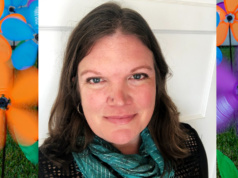Allyson Schrier joins Suzanne to talk about how a brain with dementia works differently, and how to change our approach for communicating with someone who has dementia. Allyson realized that slower-paced visuals, with music instead of words, or with the words captioned, would be easier for those with Alzheimer’s to engage with.
This led to her cofounding Zinnia TV, an app for mobile devices and connected TVs for people with Alzheimer’s and dementia that creates engagement, reduces challenging behaviors, and encourages adherence to activities of daily living. Creating an environment that supports us is part of environmental wellness, one of the 8 foundational principles of wellness, a focus this month for the Vitality Revolution podcast series sponsored by Humana.
Allyson says, “What’s really relevant for today’s conversation is the changes that impact the way that I experience the world. So, as we know, our brains are our computers, right? They’re input/output devices, and there are like 86 billion neurons that are constantly interacting with my entire body. In a very simplistic way, we can think about it such that when I am taking data in, there’s a whole bunch of communication that’s happening within my brain. Many, many, many neurons that are involved. Same thing when I am doing output, when I’m speaking, and the same thing when I’m thinking. One of the things that happens with all dementias is that those neurons, and the connections between the neurons, start to die. The brain is still going to try and have this communication, neuron to neuron to neuron. But what’s going to happen is it’s gonna go over here, and it’s gonna go ‘Ahh, bridge out, let me go this way.’ ‘Yikes, that bridge is out, this way.’ And so the result is that our processing speed slows way down. It’s not unusual for a person very early on in dementia to miss four or five words that’s spoken to them. Because I’m working so hard to process word number one, I eventually start falling behind.”
“At a time when they’re experiencing hearing loss anyway, when they’re experiencing things like macular degeneration, glaucoma, cataracts… And so you add to that the visual and the auditory processing changes, and other visual changes that occur as a result of dementia. So it means that, to create a an environment that is friendly, that takes these changes into account, I want to avoid visual and auditory clutter. So I’m going to be successful having a conversation with somebody where there isn’t a lot of competing noise. So, busy restaurants? No. While we’re shopping at Target? Not necessarily. In a room where the TV is going and there are people talking? No.
“I want to give people plenty of time. It can take somebody up to 20 seconds to respond to a question when they have dementia. So I want to make sure that I give somebody adequate time to respond. I want to slow down the way that I ask my questions, maybe use fewer words. The hearing range that we loose first is the highest range. So therefore, rather than using my high voice, I want to maybe use a lower voice when I’m talking.”
Learn more about
* Zinnia TV subscriptions, with a two-week free trial: https://www.zinniatv.com/
* Allyson Schrier: https://www.zinniatv.com/about
* The Vitality Revolution podcast series: https://answersforelders.com/vitality-revolution/
* Humana: https://www.humana.com/
* Answers for Elders: https://answersforelders.com/welcome-to-answers-for-elders/
Hear more
* Podcasts with Allyson Schrier at Answers for Elders: https://answersforelders.com/tag/allyson-schrier/
* Articles and podcasts about Environmental Wellness: https://answersforelders.com/vitality-revolution/environmental-wellness/
Answers for Elders is part of the SeniorResource Network: https://www.seniorresource.com/
Check out our affiliate podcast Alzheimer’s Speaks: https://alzheimersspeaks.com/











